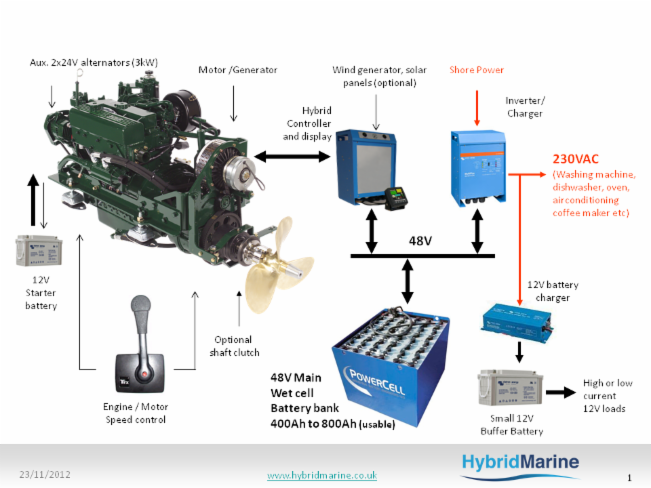Canal / Motor boat Hybrid Systems
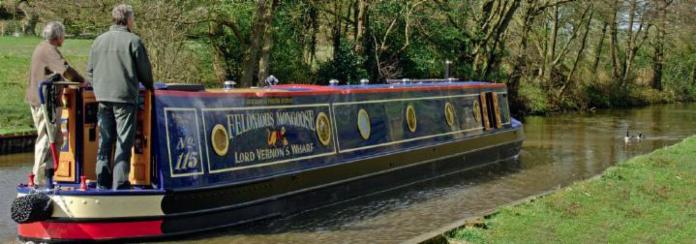
After 8 years of research and development we have selected a parallel hybrid for our canal boat systems. Using our established control technology this system provides the best feature/cost performance of all the competing hybrid configurations (see discussion What is a Hybrid? ). An integrated Hybrid system has been designed to provide a complete power and propulsion solution.
This parallel hybrid system can be fitted to a vessel during its initial construction or retrofitted to an existing diesel installation. The hybrid system does not disturb the normal shaft / propeller connection to the diesel, instead as the name implies it connects to the shaft in parallel with the standard diesel engine. Hybrid systems have the most to offer in efficiency improvements during low to mid power cruising and our system makes best use of this basic principle. The standard diesel engine is sized to provide the maximum power requirement for the vessel, while the electric drive is designed to match the boats mid range power needs. This allows the electric drive components to be smaller and provides a very cost effective hybrid solution.

Smart Morse control sets shaft speed in both engine or electric propulsion modes. In engine drive mode there is a “dead band” between centre neutral position and the point gears engage in forward or reverse. When drive does engage the minimum shaft speed is set by the engine idle speed and the gear box ratio. Frequently this minimum speed may be too high for precise control during manoeuvring. Larger boats may need to slip the engine in and out of gear to keeps speed down when docking. However the electric motor can operate at very low speeds and the Smart Morse “dead band” is used to provide fine control of the motor at slow speeds.
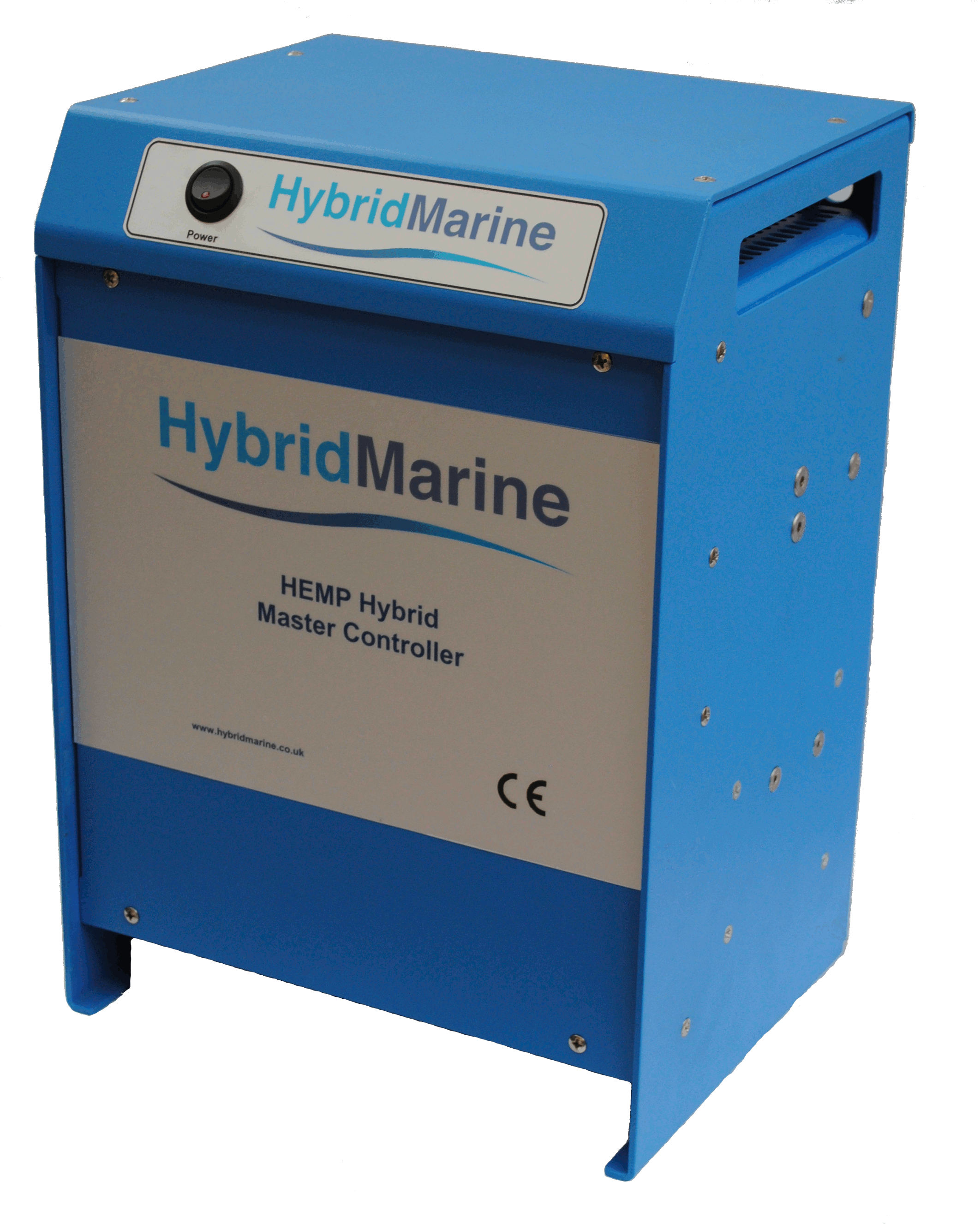
Hybrid control box
It takes approximately 3 to 5kW to move an average 20T narrow beam boat at regulated canal speeds (3 to 4 MPH). The 10kW electric motor provides this with plenty to spare for normal maneuvering. If you are operating in adverse conditions, say on a fast flowing stretch of a river, then you will need the full power of the main engine.
Typically the engine is operating at just over tick over speeds (1,200 to 1,400 RPM) in restricted waters. The canal boat hybrid is designed specifically to provide 7kW of power generation when cruising at this low engine speed.
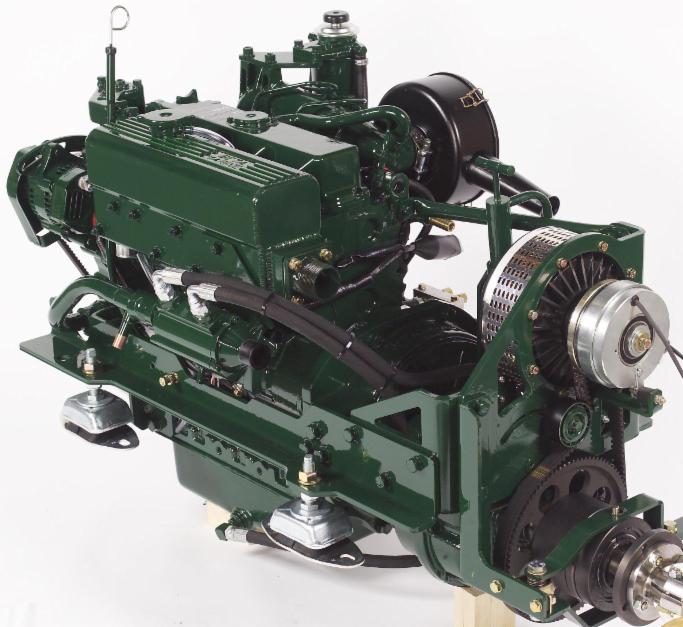
Beta 43hp based hybrid with 10kW electric drive and 7kW generator capability
How does the system work ?
In normal canal conditions you can drive on the electric motor for prolonged periods. How long you can go on electric drive depends on the size of your batteries. A 48V / 400Ah battery bank would last around 3 to 5 hours, a larger bank of around 48V/800Ah would last 6-10 hours. Keep in mind this is continuous operation. If you are transiting a flight of locks then you are only using electrical power when moving. This eliminates idling the engine in locks and provides considerable savings in fuel.
When the batteries run down you start the engine and drive in the normal way. At this time the hybrid automatically becomes a generator to recharge the batteries. At typical propulsion speeds the batteries are quickly recharged via the powerful 7kW hybrid generator. Every hour of engine drive can store enough energy in the batteries to travel between 1 and 2 hours in electric drive.
After the batteries are recharged you can go back to electric drive or save the energy stored for powering your electrical circuits in the evening.
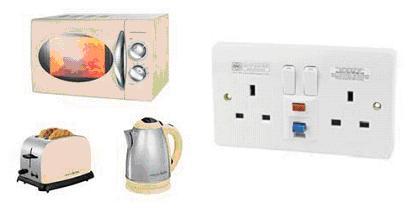
System Features and functions
- Whisper quiet electric operation yet the vessels standard diesel engine remains available to meet high end power requirements.
- Listen to the leaves rustling in the trees and observe the wildlife as never before
- No more idling in locks, you can breathe fresh air and actually hear your crew from the bottom of the lock
- Power your entire boat with the onboard hybrid generator and battery bank. No more charging in the evening to top up substandard 12V batteries.
- Run a powerful ring main via an inverter from the large battery bank. Cook electric in complete silence and eliminate gas onboard.
- Significant reduction in fuel consumption and engine hours.
- Build your canal boat for very little extra, see hybrid packages
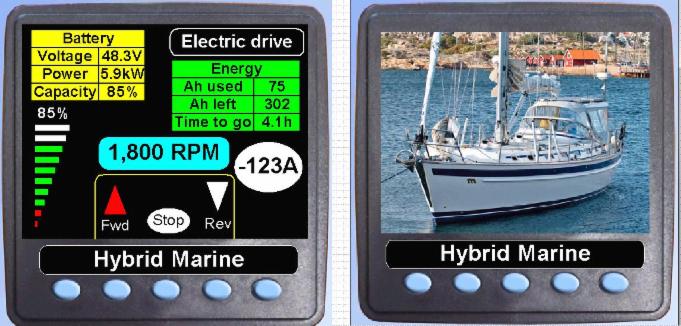
Example hybrid display screens, download as a PDF
What our customers say
Enough about our ideas here are what our customers say
Narrow Boat Chelonian.
My requirements for a electric/hybrid drive were as follows.
1. provide the same range and power as a conventional diesel system.
2. allow silent electric propulsion for extended periods (hours)
3. allow a practical mix of diesel/electric drive without extended battery recovery time.
4. allow the propulsion batteries to be utilized to provide domestic electrical power.
The hybrid marine solution fulfils all of these requirements. Using the parallel hybrid design allows the full power and extended range of the diesel engine to be used without compromise allowing sufficient power for river and tidal crossings, and the extended cruising range (200 hours) to be maintained. In addition the electric drive can be used when appropriate to provide extended silent cruising or around 4 hours, or more if lock passage included. The use of the propulsion motor as a generator when using diesel propulsion allows a quick recharge of the batteries with approximately a 50/50 diesel/electric duty cycle. this means that using the electric drive is a regular daily part of the days operation rather than a special event.
The use of a standard 48v battery plant means that standard off the shelf inverter/ charger systems designed for marine use are available at reasonable cost (Victron Multiplus 48/30). The capability of these units to provide high power outputs in parallel mode (10kw +) makes it practical to replace the gas cooking appliances with electric hobs and ovens, improving safety and usability. This has been a major improvement to the services on board as in common with most canal boats using "leisure" batteries for domestic electrical power the systems are almost always under powered and careful management of the available electrical power is needed to avoid exhausting the batteries on a daily basis. Also the regular deep discharging of "leisure" batteries means a short life before significant loss of capacity with regular replacement every three years or so. The use of deep discharge traction cells has also meant that the system is now in it's 3rd year of operation with no significant loss of battery capacity and worrying about running out of domestic electrical power is a thing of the past. In addition the large capacity 230v system allows the inclusion of a washer dryer on board, a major benefit on a wet cold windy day ! Other electrical appliances that would not be contemplated on a conventional boat include an electric kettle, a bread maker and toaster all improving the convenience and usability of the boat.
In addition to meeting the original requirements the system also provides a number of additional benefits. The system has shown a dramatic saving in fuel overall with the predicted consumption per hour when using the diesel for propulsion and electrical charging being typical of a conventional boat using the same engine (i.e. no increase in fuel consumption to recharge the batteries) using electric propulsion for around 50% of the cruising time, and virtually eliminating the need to run the engine solely for battery charging has meant that the boat uses significantly less than half the diesel fuel of an equivalent conventional boat. In addition the replacement of the gas cooking with electricity further reduces the operating costs and carbon emissions. Additionally the reduced engine hours result in savings in servicing costs.
The use of electric propulsion results in a whole new experience of cruising, reducing the impact on the environment from noise and vibration. It is noticeable that you get to hear all the sounds of the countryside such as the birds singing that are usually drowned out by the engine. It is also noticed that the canal side wildlife such as herons and kingfishers can be approached much closer when on electric drive. The silent electric drive also has safety and operational benefits, particularly when maneuvering and operating locks as the person on the helm can now communicate verbally with the crew elsewhere on the boat and on the ground, something which is rarely possible even shouting when standing on top of an idling diesel engine.
The large capacity propulsion battery also means that extended "off net" stays on the bank are possible without needing to resort to extended operation of the Diesel for battery charging. A fully charged battery on Chelonian allows up to 4 days of domestic use including cooking using approximately 4Kwh per day. If necessary an hours operation of the diesel in charging mode will provide enough power for a days domestic consumption. Before the hybrid conversion it would be necessary to run the diesel for approximately 4 hours a day to charge the domestic batteries for a nights power. Using approximately 6 liters of diesel (approx. 60kwh) to generate around 1.5Kwh of stored electrical energy, a horribly inefficient way to obtain electrical energy.
In many places canal side electrical points are becoming available, for instance at some Thames locks, popular destination (e.g. llangollen canal terminus) and at most marinas. Charges for these vary from around 15p a unit to around £5 per day often included in an overnight mooring charge. By managing the battery state to arrive at these locations with a discharged battery it is possible to make very effective use of mains power for propulsion. A fully charged battery will provide in excess of 4 hours cruising replacing Around 6L of fuel at a cost of around £6. A full charge consumes around 20Kwh or £3 of electricity.
Dave McInerney. Canal Boat Chelonian
Note : Chelonian has a 48V/450Ah battery bank providing 4-6 hours of electric cruising and enough energy to eliminate gas on board (electric cooking).Download Brochure for production systems (PDF, 600kB)
Narrow Boat Volta
Since the Hybrid was fitted (and excluding the trip where I’d not switched it on!) the major trips undertaken have been from our home mooring on the Shropshire Union Canal to Manchester and the Peak Forest; down the River Severn and up the Avon to Stratford with return via Coventry and the Ashby Canal; and around the Four Counties ring, including the Caldon Canal, finishing with a trip up the Llangollen Canal to our new winter mooring at Chirk.
These trips totaled about 750 miles and 450 locks, taking about 360 hours. Although I have not kept a detailed log of hours, from the engine hour recorder I have estimated usage as 70:30 engine/electric. Actual ‘running’ electric time is probably slightly less than this because it is not necessary to ‘use’ the electric drive when stationary in locks.
I have increasingly learnt how to make best use of the electric drive. In my mind I now plan each day to ensure that if there is flight of locks or a tunnel coming up then the batteries are charged ready for then, as those are the times at which the greatest benefits in terms of silence and lack of diesel exhaust are appreciated. Also at long lock flights there is a significant fuel saving without a diesel engine running in neutral, for which can be hours. Passing through the longer tunnels is a totally different experience with only the sounds of the water dripping from the roof and the wash from the propeller to be heard rather than the reverberating sound of the engine exaggerated in the confined space.
On a day when there are no significant features to be planned for then, depending on the length of the cruising day, it is usually possible to fit in one or two periods of electric running. I find that recharging the batteries using the hybrid takes just slightly longer than one has been running on the electric drive, say after two hours running fully recharging takes about 2¼ to 2½ hours.
If wishing to observe wildlife the electric drive can certainly provide opportunities that would not happen if running on the diesel engine. I clearly recall passing through a bridge, under which a heron was taking the opportunity to fish in the dry, where our passing in near silence only made him step back a pace from the edge; and seeing some, all too rare now, watervoles on the Ashby Canal who appeared little disturbed by our passing.
As well as the perhaps more obvious benefits of the hybrid, some less apparent benefits have been found. For example, being able to hear others coming when approaching blind bridge holes and thus avoid potential collision or very rapid reversing (although I’m sure the day will come when I meet another electric narrowboat!); the ability to hold conversations with those on the towpath, although the subject is often the same, about Volta and her quiet ‘engine’ (followed by a disbelief that a narrowboat can be electric!); and the advantage of simply having the battery capacity needed for the hybrid available for ‘domestic’ use when staying on a mooring for any length of time without moving - with others around running their engines for hours recharging we can last for days in silence!
We look forward to 2011’s extended ‘expedition’, planned to take in London, the Kennet & Avon Canal and the River Thames (as well as many shorter diversions), when we’re sure Volta and her electric drive will be a recurrent talking point.
Stephen & Lynda Bean, Canal boat "Volta"
Note : Planing of Volta's hybrid installation came later on in the build schedule. Due to this we were not able to install the usual large bank of wet lead/acid cells. As a result we installed a smaller bank of dry cells arranged around the swim. At 48V/200Ah this battery bank still provides 2 hours of electric cruising
Canal boat "Felonious Mongoose"
"Felonious Mongoose has been used to explore the English and Welsh navigable canals and waterways, making as little use as possible of the diesel engine.
Total miles 2009 and 2010, 1805 miles, with a total diesel engine use (for all purposes) 231.8 hours. Assuming 3mph on when running the Diesel this gives 695 miles on diesel and 1106 electric miles. Diesel has only once been run for half an hour for charging along side the canal bank – I have ignored this in the calculations. At all other times diesel use has been for both propulsion and charging. Further extrapolating from these calculations, assuming 2.2 mph when using the electric motor, this gives 503 hours for electric propulsion".
Charley and Dolores Johnson
Note |: Felonious Mongoose Has a large 48V/890Ah battery bank and can cruise for two days on electric drive. Arriving at a marina with depleted batteries the owner can recharge overnight and be ready for another two days of electric cruising. In two years of continuous cruising the owner has only used the hybrid for canal bank charging once (for half an hour). The owner also notes that when operating in the tidal parts of the Thames he was very glad to have the full power of the engine available.
If you are building a boat or going through a refit then take a look at our Packages
